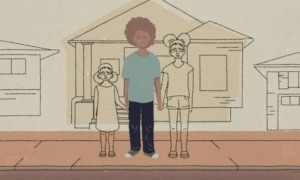This story was originally produced by The Hechinger Report, a nonprofit, nonpartisan news outlet focused on education.
Imagine waking up each morning with no hope for the day ahead, navigating a minefield of potential conflicts with your body on high alert. That was my reality as a marginalized youth — misunderstood, labeled as a troublemaker and cast out without a chance to reconcile and evolve. Growing up with anxiety in school is an all-too-common experience that perpetuates a cycle of fear and resentment. It’s time to acknowledge and address this narrative that adversely affects our youth’s learning experiences and the education system.
Moving away from suspensions can help students become more engaged members of their schools.
Negative labeling of students can severely impact their confidence and sense of self. As a former “troublemaker,” I know firsthand how difficult it can be to overcome such labeling.
Participating in a restorative justice program allowed me to take responsibility for my actions, repair relationships and gain the confidence I needed to succeed. By providing restorative justice programs, we can help students become positive and engaged members of their school communities.
Restorative justice is an alternative to suspension that involves having those in conflict talk through their issues with a mediator. The goal is for students who have misbehaved to understand any harm they’ve caused and work to repair it and restore relationships. It offers a beacon of hope, a transformative approach prioritizing connection over isolation and understanding over punitive discipline.
Students need to feel that those with power see their life experiences. They should not be subjected to pointless punishment that has no value other than the punishment itself.
Restorative justice empowers students to take responsibility for their actions. Providing a safe dialogue space helps students learn how to communicate effectively, build empathy and establish trust with their peers and teachers. By embracing restorative justice, schools can create a culture of accountability, healing and growth that benefits everyone involved.
[Related: What does restorative justice look like?]
But restorative justice is not just about addressing behavior problems; it’s also about addressing the underlying issues driving those behaviors, often stemming from trauma, neglect or systemic injustices. Restorative justice recognizes that everyone has unique circumstances and challenges and deserves personalized support to address their needs.
It’s about breaking the cycle of fear and punitive discipline.
Many students do not have access to the resources needed to address their mental and emotional concerns, and they do not have the proper tools to deal with everything they go through in their lives. Instead, they manifest their struggles through misbehavior. They need someone to recognize their lived experiences and help them confront the sources of their actions.
Responding to misbehavior in this supportive way is a paradigm shift from punitive measures that only serve to alienate and perpetuate cycles of violence and incarceration.
In marginalized communities, where access to mental health support is often limited and stigmatized, restorative justice can be a lifeline. Instead of funneling youth into the school-to-prison pipeline, we must invest in their potential by providing access to counseling, therapy and other resources that address the root causes of their behavior. This process starts at the ground level: Those who see students daily need to be the first ones to help them address their issues.
Restorative justice provides students the tools to go forth into the world as optimistic, encouraged and emotionally intelligent individuals — allowing them a greater chance to reach their goals.
Implementing restorative justice requires a concerted effort from educators, administrators and policymakers. It starts with training in restorative practices, creating safe spaces for dialogue and conflict resolution and collaborating with mental health professionals to provide holistic support.
Challenges and resistance are inevitable. Skepticism and fear of change are formidable barriers, as are entrenched policies and funding allocations that prioritize punishment over rehabilitation. However, the success stories of restorative justice programs nationwide prove that change is possible and necessary.
[Related: Giving first-time juvenile offenders avenues away from detention in New York]
Reflecting on my journey from fear to advocacy, I am reminded of the transformative power of restorative justice. It’s not just about breaking down walls; it’s about building bridges of understanding and compassion. It’s about breaking the cycle of fear and punitive discipline.
Seeing the positive impact of restorative justice on our school community motivated me to become certified in restorative justice. Now, I’m able to help others in my community find ways to resolve conflicts and build stronger, more meaningful relationships through restorative practices.
It won’t happen overnight, but with perseverance and collective effort, we can create school systems in which every student feels seen, heard and valued. It’s time to tear down the walls of injustice and build bridges to a brighter future for all.
***
Jully Myrthil is a high school senior in Rhode Island and a passionate advocate for fostering understanding, inclusion and justice for all. She is a co-founder of Shades of Knowledge, a nonprofit dedicated to making education and literature accessible to all youth worldwide.
Keira Boxell, fellow co-founder of Shades of Knowledge, contributed to this piece.
The Hechinger Report is a nonprofit, independent news organization focused on inequality and innovation in education. Sign up for Hechinger’s newsletter.

























